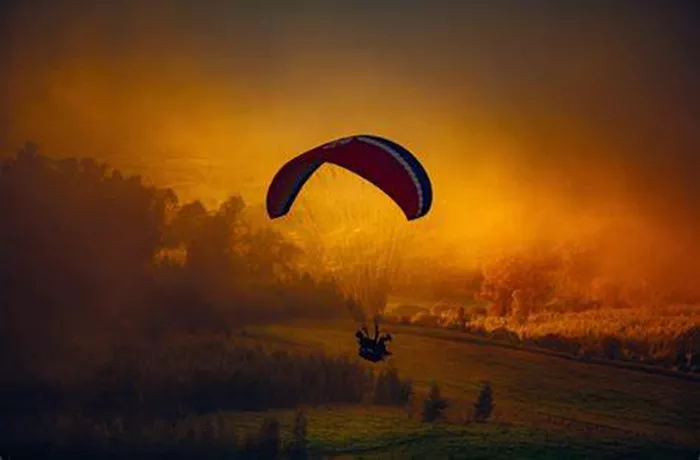Paragliding offers a thrilling way to experience the world from above, but choosing the optimal time of day for your flight can significantly impact your safety and enjoyment. This article delves into whether it’s better to paraglide in the morning or evening by examining the atmospheric conditions, wind patterns, and safety considerations associated with each time of day.
Atmospheric Conditions: Morning vs. Evening
Morning Conditions
- Temperature and Stability
- Cooler Air: The cooler air in the morning is denser, which provides better lift and more stable flying conditions. The absence of strong thermal activity during this time contributes to a smoother flight.
- Increased Stability: With less thermal turbulence in the morning, pilots experience more stable air, making it easier to control the paraglider and enjoy a more comfortable flight.
- Humidity and Dew
- Dew Formation: Dew is common in the morning and can affect the launch site by making it slippery. Pilots should check the conditions to ensure a safe takeoff.
- Humidity Levels: Higher morning humidity may slightly impact wing performance, though this effect is usually minimal compared to other factors.
Evening Conditions
- Temperature and Thermal Activity
- Warming Air: As the day progresses, the air warms up, increasing thermal activity. This can lead to stronger, unpredictable wind currents and turbulence, making evening flights more challenging.
- Thermal Currents: The evening’s thermal activity, resulting from the day’s heating, can create lift and turbulence, which may impact flight stability and control.
- Wind Patterns
- Wind Changes: Evening wind patterns can be less predictable due to the cooling of the ground and changes in air density. Pilots may encounter gusts and shifts in wind direction.
- Evening Calm: In some regions, the evening may bring calmer winds after the peak heat of the day, offering a brief period of more stable conditions for experienced pilots.
Wind Patterns and Safety
Morning Wind Patterns
- Calm and Predictable Winds
- Consistency: Mornings generally offer more consistent and predictable wind patterns, thanks to lower thermal activity and less influence from the sun’s heat.
- Pre-Flight Checks: The stable wind conditions in the morning make it easier to conduct pre-flight checks, ensuring a safer launch and landing.
- Thermal Winds
- Lower Thermals: The reduced thermal activity in the morning decreases the likelihood of encountering sudden gusts or turbulence, contributing to a safer and more enjoyable flight.
Evening Wind Patterns
- Increased Thermal Activity
- Unpredictable Winds: Increased thermal activity in the evening can lead to more unpredictable wind patterns, resulting in sudden gusts and turbulence.
- Wind Shifts: Evening winds can shift rapidly as the sun sets and the ground cools, requiring pilots to remain vigilant and adapt to changing conditions.
- Calm Periods
- Transition Periods: Some areas experience a brief period of calm winds before sunset, which can be ideal for experienced pilots who are familiar with local conditions and can handle variable winds.
Impact on Flight Experience
see also: How Paragliding for Beginners
Morning Flights
- Enhanced Visibility
- Clearer Views: Mornings often provide clearer air and better visibility, enhancing the flight experience and aiding navigation. Pilots can enjoy panoramic views and a more serene environment.
- Less Air Traffic: Early morning flights may encounter less air traffic, reducing the risk of mid-air collisions and contributing to a more peaceful flying experience.
- Longer Flight Duration
- Stable Conditions: The stable conditions in the morning allow for longer and more enjoyable flights. Pilots can take advantage of the calm air to explore and appreciate their surroundings.
Evening Flights
- Scenic Beauty
- Sunset Views: Evening flights offer the unique opportunity to experience stunning sunset views from the air. The changing colors and lighting create a picturesque backdrop for the flight.
- Cooler Temperatures: The cooler evening temperatures can be more comfortable, especially after a hot day, adding to the overall enjoyment of the flight.
- Shorter Flight Duration
- Variable Conditions: Increased turbulence and variable wind conditions in the evening may limit flight duration. Pilots may need to cut their flights short to avoid unsafe conditions.
Conclusion
Choosing the optimal time for paragliding depends on various factors, including weather conditions and personal preferences. Mornings generally offer more stable and predictable conditions, making them ideal for a safer and longer flight. Evenings provide unique experiences, such as stunning sunsets and cooler temperatures, but come with increased risks due to thermal activity and variable winds. By understanding the advantages and challenges of each time of day, you can make an informed decision to ensure a thrilling and safe paragliding adventure.
FAQs:
What time of day is best for paragliding beginners?
For beginners, mornings are usually the best time to paraglide due to more stable and predictable wind conditions, which provide a safer environment for learning and practice.
How does thermal activity affect evening paragliding?
In the evening, increased thermal activity can lead to unpredictable wind patterns and turbulence, making the flight more challenging and requiring greater skill to manage.
Can paragliding conditions vary significantly between different locations?
Yes, paragliding conditions can vary widely based on local topography, weather patterns, and seasonal changes, affecting the optimal time for flying.
What safety precautions should I take for evening paragliding?
When paragliding in the evening, monitor wind patterns closely, be prepared for sudden changes, and ensure you have adequate lighting for a safe landing if flying close to dusk.
related topics:
- 6 Best Place for Paragliding in Switzerland
- 5 Best Ultralight Paragliding Harness of 2024
- Can You Do Paragliding in Winter?

